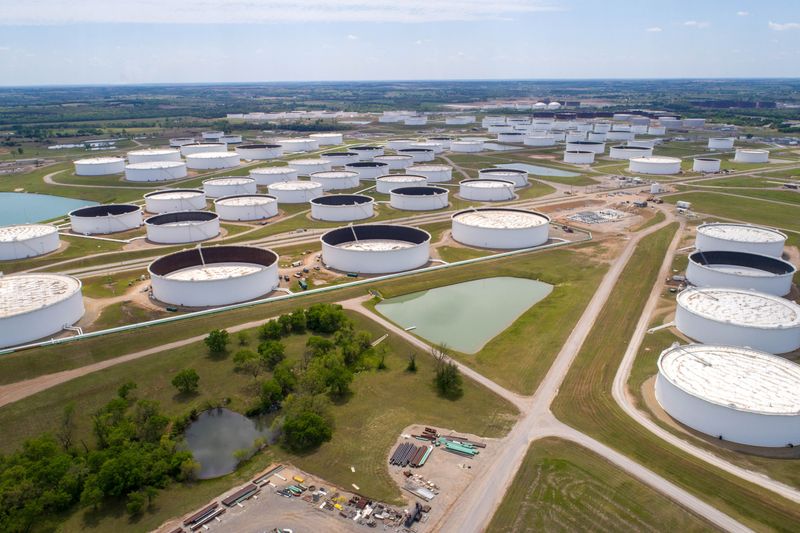Commodities
Oil eases ahead of Christmas break on possible future Angola output increase


© Reuters. Crude oil storage tanks are seen in an aerial photograph at the Cushing oil hub in Cushing, Oklahoma, U.S. April 21, 2020. REUTERS/Drone Base/file photo
By Scott DiSavino
NEW YORK (Reuters) – Oil prices eased on Friday ahead of the long Christmas holiday weekend on expectations Angola could increase output after leaving OPEC, but rose for the week on positive U.S. economic news and worries Houthi ship attacks would boost supply costs.
futures fell 32 cents, or 0.4%, to settle at $79.07 a barrel, while U.S. West Texas Intermediate (WTI) crude fell 33 cents, or 0.5%, to settle at $73.56.
That left both benchmarks up about 3% for the week after gaining less than 1% last week.
In the Middle East, more maritime carriers said they were avoiding the Red Sea due to attacks on vessels carried out by the Iranian-backed Houthi militant group, which says it is responding to Israel’s war in Gaza.
Major shippers Maersk and CMA CGM said they would impose extra charges linked to re-routing ships.
The attacks have caused disruptions through the Suez Canal, which handles about 12% of world trade.
“Direct pauses to supply are not the only reason oil prices will be moved by the Red Sea situation; freight rates and insurance costs are increasing,” said PVM analyst John Evans about the impact of the disruption.
In Africa, meanwhile, Angola’s decision to leave the Organization of the Petroleum Exporting Countries (OPEC) could open the way for Beijing to increase investment in the country’s oil and other sectors. Angola produces about 1.1 million barrels per day of oil.
“It will take time for Angola oil production to rise even if China moves in there in a big way,” said Phil Flynn, an analyst at Price Futures Group, noting that the U.S. inflation data and Houthi attacks in the Red Sea should be more supportive of oil prices than any future increase in output from Angola.
In Iraq, meanwhile, oil ministry spokesman Asim Jihad affirmed Iraq’s support for the OPEC+ agreement and its commitment to voluntary oil cuts.
OPEC+ includes OPEC and allies like Russia.
U.S INFLATION EASES
In the U.S., a key inflation reading came in softer than expected, boosting investor optimism that the U.S. Federal Reserve (Fed) would lower borrowing costs next year.
Lower interest rates cut consumer borrowing costs, which can boost economic growth and demand for oil.
Expectations that the Fed is more likely to cut interest rates next year also helped reduce the U.S. dollar to its lowest since July against a basket of other currencies for a second day in a row.
A weaker dollar can boost oil demand by making the fuel more expensive for buyers using other currencies.
But all U.S. economic news was not positive.
Sales of new U.S. single-family homes dropped to a one-year low in November, but the unexpected decline is probably temporary amid a chronic shortage of previously owned homes, which has been supporting demand for new construction.
Commodities
Oil prices rise; U.S. crude inventories plunge, Russia-Ukraine truce eyed
Commodities
India’s Reliance to stop buying Venezuelan oil over US tariffs, sources say
Commodities
Oil prices climb on Venezuela supply worries

 Forex3 years ago
Forex3 years agoForex Today: the dollar is gaining strength amid gloomy sentiment at the start of the Fed’s week

 Forex3 years ago
Forex3 years agoUnbiased review of Pocket Option broker

 Forex3 years ago
Forex3 years agoDollar to pound sterling exchange rate today: Pound plummeted to its lowest since 1985

 Forex3 years ago
Forex3 years agoHow is the Australian dollar doing today?

 Cryptocurrency3 years ago
Cryptocurrency3 years agoWhat happened in the crypto market – current events today

 World3 years ago
World3 years agoWhy are modern video games an art form?

 Commodities3 years ago
Commodities3 years agoCopper continues to fall in price on expectations of lower demand in China

 Economy3 years ago
Economy3 years agoCrude oil tankers double in price due to EU anti-Russian sanctions























